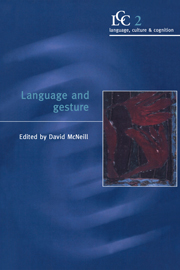Book contents
- Frontmatter
- Contents
- Acknowledgments
- Introduction
- Part 1 Gesture in action
- Part 2 Gesture in thought
- 7 Growth points in thinking-for-speaking
- 8 How representational gestures help speaking
- 9 Where do most spontaneous representational gestures actually occur with respect to speech?
- 10 Gesture production during stuttered speech: insights into the nature of gesture–speech integration
- 11 The role of gestures and other graded language forms in the grounding of reference in perception
- 12 Gesture and the transition from one- to two-word speech: when hand and mouth come together
- Part 3 Modeling gesture performance
- Part 4 From gesture to sign
- Index
8 - How representational gestures help speaking
Published online by Cambridge University Press: 07 January 2010
- Frontmatter
- Contents
- Acknowledgments
- Introduction
- Part 1 Gesture in action
- Part 2 Gesture in thought
- 7 Growth points in thinking-for-speaking
- 8 How representational gestures help speaking
- 9 Where do most spontaneous representational gestures actually occur with respect to speech?
- 10 Gesture production during stuttered speech: insights into the nature of gesture–speech integration
- 11 The role of gestures and other graded language forms in the grounding of reference in perception
- 12 Gesture and the transition from one- to two-word speech: when hand and mouth come together
- Part 3 Modeling gesture performance
- Part 4 From gesture to sign
- Index
Summary
Introduction
The purpose of this chapter is to discuss the speaker-internal motivation to produce representational gestures. Consequently, the communicative aspects of gesture will be backgrounded in the following discussion, and the main focus will be on the cognitive functions of representational gestures. Representational gestures are defined here as iconic gestures and abstract deictic gestures (McNeill 1992). In an iconic gesture there is a certain degree of isomorphism between the shape of the gesture and the entity that is expressed by the gesture. An abstract deictic gesture points to a seemingly empty space in front of the body, as if establishing a virtual object in the gesture space or pointing at such a virtual object. Because these gestures have a relatively transparent form–function relationship, they play an important role in communication.
However, it is known that people also produce representational gestures without visual contact with the interlocutor, although under such a condition the frequency decreases (Rimé 1983). This cannot be fully explained as a habit formed during more frequent face-to-face interactions. This is because certain types of gestures that are meant to be seen are not produced if there is no visual contact with the interlocutor. For example, waving a hand to mean “Bye-bye” at the end of a phone conversation feels extremely unnatural. Bavelas et al. (1992) experimentally demonstrated that ‘interactive gestures’, whose signification function involves other participants in the speech event, are produced less frequently when there is no visual contact between the interactants.
- Type
- Chapter
- Information
- Language and Gesture , pp. 162 - 185Publisher: Cambridge University PressPrint publication year: 2000
- 290
- Cited by

